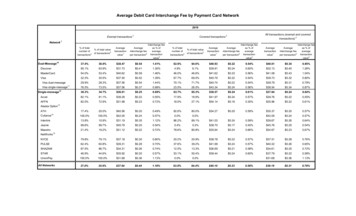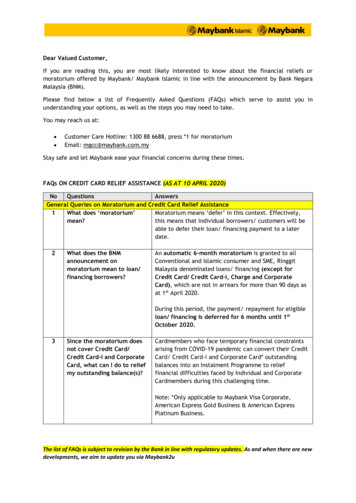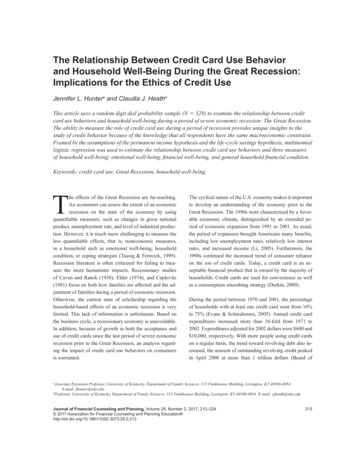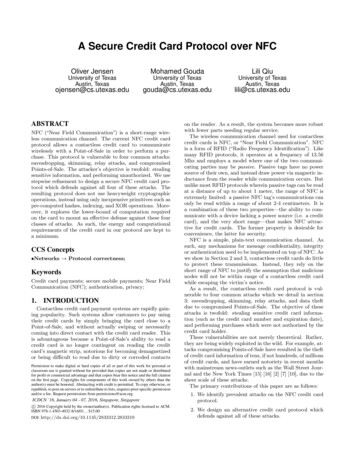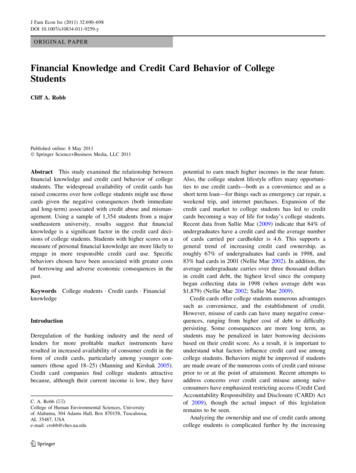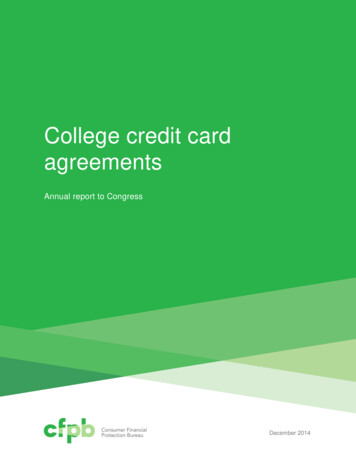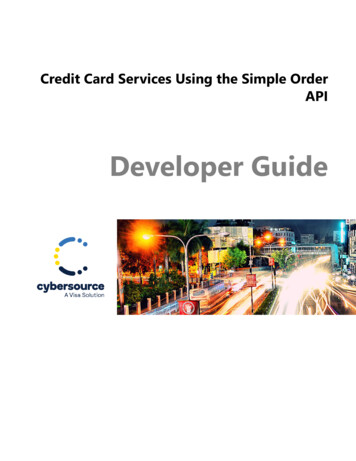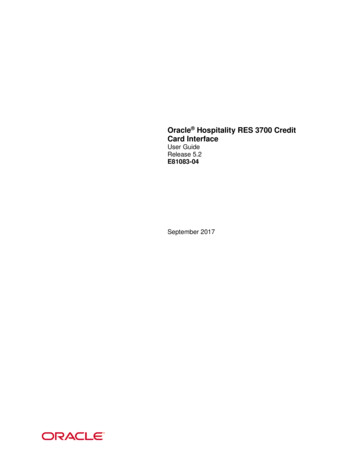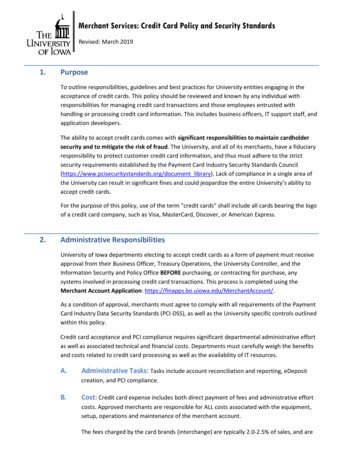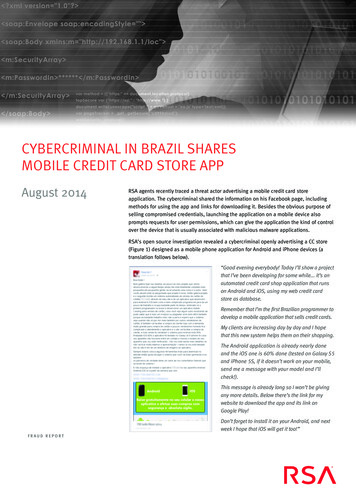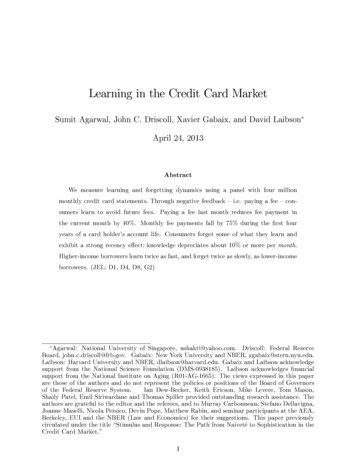
Transcription
Learning in the Credit Card MarketSumit Agarwal, John C. Driscoll, Xavier Gabaix, and David LaibsonApril 24, 2013AbstractWe measure learning and forgetting dynamics using a panel with four millionmonthly credit card statements. Through negative feedback – i.e. paying a fee – consumers learn to avoid future fees. Paying a fee last month reduces fee payment inthe current month by 40%. Monthly fee payments fall by 75% during the rst fouryears of a card holder’s account life. Consumers forget some of what they learn andexhibit a strong recency e ect: knowledge depreciates about 10% or more per month.Higher-income borrowers learn twice as fast, and forget twice as slowly, as lower-incomeborrowers. (JEL: D1, D4, D8, G2)Agarwal: National University of Singapore, ushakri@yahoo.com. Driscoll: Federal ReserveBoard, john.c.driscoll@frb.gov. Gabaix: New York University and NBER, xgabaix@stern.nyu.edu.Laibson: Harvard University and NBER, dlaibson@harvard.edu. Gabaix and Laibson acknowledgesupport from the National Science Foundation (DMS-0938185). Laibson acknowledges nancialsupport from the National Institute on Aging (R01-AG-1665). The views expressed in this paperare those of the authors and do not represent the policies or positions of the Board of Governorsof the Federal Reserve System.Ian Dew-Becker, Keith Ericson, Mike Levere, Tom Mason,Shaily Patel, Emil Siriwardane and Thomas Spiller provided outstanding research assistance. Theauthors are grateful to the editor and the referees, and to Murray Carbonneau, Stefano Dellavigna,Joanne Maselli, Nicola Persico, Devin Pope, Matthew Rabin, and seminar participants at the AEA,Berkeley, EUI and the NBER (Law and Economics) for their suggestions. This paper previouslycirculated under the title “Stimulus and Response: The Path from Naiveté to Sophistication in theCredit Card Market.”1
1IntroductionEconomists often motivate optimization and equilibrium as the outcome of learning. Ac-cordingly, learning is a key mechanism that underpins economic theories of rational behavior.Many economic studies have analyzed learning in the lab1 and the eld.2 However,because of data limitations, only a few papers have measured learning with householdlevel panel data. Such studies usually nd that households improve their decisions as theyacquire more experience. For example, Miravete (2003) and Agarwal, Chomsisengphet, Liuand Souleles (2006) respectively show that consumers switch telephone calling plans andcredit card contracts to minimize monthly bill payments. Ketcham, Lucarelli, Miravete andRoebuck (2012) show that Medicare Part D enrollees initially choose suboptimal plans andimprove over time.3DellaVigna and Malmendier (2006) show that gym usage rises formembers who renew their annual contracts. Several papers are able to identify the speci cinformation ‡ows that elicit learning. Haselhuhn, Pope, Schweitzer and Fishman (2012) ndthat renters at video stores are more likely to return their videos on time if they have recentlybeen ned for returning them late. Grubb and Osborne (2012) nd that “bill shock”appearsto draw consumers’attention to past cellular phone usage.4In the current paper, we study credit card behavior. Credit cards are used by the vastmajority of U.S. households, and have become a signi cant source of household credit. Inthe U.S. alone, households carry 850 billion of revolving debt, implying 7,000 of revolvingdebt on average per household.5In addition to interest payment, credit card fees have also become a meaningful component of the implicit price of credit card usage. We study household level payments of add-on1For example, Van Huyck, Cook and Battalio (1994), Crawford (1995), Roth and Erev (1995), Camerer(2003), and Wixted (2004).2For example, see Bahk and Gort (1993), Marimon and Sunder (1994), Thornton and Thompson (2001),and Malmendier and Nagel (2011).3This initial suboptimality is also demonstrated in cross-sectional data in work by Heiss, McFadden, andWinter (2007), Abaluck and Gruber (2011), and Kling, Mullainathan, Sha r, Vermeulen, and Wrobel (2011).4Other papers documenting apparent instances of learning in the eld include Ho and Chong (2003),who use grocery store scanner data to estimate a model in which consumers learn about product attributes.Their learning model has greater predictive power, with fewer parameters, than forecasting models used byretailers. Lemieux and MacLeod (2000) study the e ect of an increase in unemployment bene ts in Canada.They nd that the propensity to collect unemployment bene ts increases as a consequence of a previousunemployment spell. Odean, Strahlevitz and Barber (2010) nd evidence that individual investors tendto repurchase stocks that they previously sold for a gain. Dellavigna (2009) surveys the eld evidence onbehavioral phenomena.5Board of Governors of the Federal Reserve System, Flow of Funds (G-19), preliminary 2012 data.2
fees in the credit card market— late payment, over limit, and cash advance fees.6Someobservers argue that account holders do not optimally minimize such fees.7 We measure theways in which fee payments change as credit card holders gain experience. To do this, webuild a novel panel dataset that contains three years of credit card transactions, representing 128,000 consumers and 4,000,000 monthly statements. Our analysis reveals substantialfee-based learning, and a surprisingly large amount of subsequent forgetting.We nd that new credit card accounts generate direct monthly fee payments (not including interest) averaging about 14 per month.8 We also nd that these payments fall byabout 75 percent during the rst four years of account life. These fee dynamics are probablygenerated by several di erent channels.Consumers learn more about the existence andmagnitude of fees when they knowingly or accidentally trigger them. Painful fee paymentsmay also train account holders to be more vigilant in their card usage.Our analysis reveals that the learning dynamics are not monotonic. Card holders act asif their knowledge fades – i.e., learning patterns exhibit a recency e ect.9 A late paymentcharge from the previous month engenders a high level of fee avoidance this month, andthis response is much stronger than the fee avoidance engendered by a late payment chargethat occurred many months ago. We estimate that the learning e ect of a fee paymente ectively depreciates at a rate of between 10 and 20 percent per month. At rst glance,such depreciation is counter-intuitive. However, if attention is a scarce resource, attention6Ausubel (1991, 1999), Shui and Ausubel (2004) and Kerr and Dunn (2008) analyze the magnitude ofinterest payments and fees in the credit card market.7For example, Frontline reports that “The new billions in revenue re‡ect an age-old habit of humanbehavior: Most people never anticipate they will pay late, so they do not shop around for better latefees.” dit/more/rise.html) There is also a nascentacademic literature that studies how perfectly rational rms interact in equilibrium with imperfectly rationalconsumers. Aide from the papers on Medicare Part D above, see Shui and Ausubel (2004), DellaVigna andMalmendier (2004), Mullainathan and Shleifer (2005), Oster and Morton (2005), Gabaix and Laibson (2006),Jin and Leslie (2003), Koszegi and Rabin (2006), Malmendier and Shanthikumar (2007), Grubb (2009), andBertrand et al. (2010). Spiegler (2011) provides an overview. It is important to note that much of thisliterature studies cross-sectional data, and is therefore not able to study learning with as much ease as studiesusing panel data.8Moreover, this understates the impact of fees, since some behavior — e.g. a pair of late payments —not only triggers direct fees but also triggers an interest rate increase, which is not captured in our 14calculation. Suppose that a consumer is carrying 2,000 of debt. Changing the consumer’s interest ratefrom 10% to 20% is equivalent to charging the consumer an extra 200 per year. Late payments alsomay prompt a report to the credit bureau, adversely a ecting the card holder’s credit accessability andcreditworthness. The average consumer has 4.8 cards and 2.7 actively used cards.9See Lehrer (1988), Aumann, Hart and Perry (1997) and Besanko et al. (2010) for some theoreticalmodels of forgetfulness.3
may wander as the salience of a past fee payment declines. After making a costly mistake(e.g., getting a speeding ticket), people are likely to pay attention and avoid repeating themistake; however as the painful event becomes a distant memory, vigilance may fade withthe recency of the memory.There are several others papers that have documented forgetting e ects. For instance,Benkard (2000) nds evidence for both organizational learning and forgetting – that is,depreciation of productivity over time – in the manufacturing of aircraft, as do Argote,Beckman and Epple (1990), in shipbuilding.Ericson (2011) shows that subjects forgetto pick up a delayed monetary reward (and underforecast their own tendency to forget).Malmendier and Nagel (2011) document a recency e ect in stock market forecasts –peopleweight recent returns, which they personally experienced, more heavily than older historicalreturns.10 In more closely related work, Haselhuhn, Pope, Schweitzer and Fishman (2012) nd that the e ect of past late payment nes on current nes declines as time passes.Gallagher (2012) documents that ‡ood insurance take-up rates rise in the year a ‡ood occursin that community, but fall in the years thereafter.We analyze many of the plausible mechanisms that may explain the fee dynamics that wemeasure. We rst explore several explanations that are not consistent with our benchmarkmodel of learning/forgetting –for example, that card usage might be negatively autocorrelated –and nd that these alternative explanations are not consistent with the data. Nextwe nd that (i) the speed of net learning, (ii) the magnitude of the recency e ect, and (iii)the speed of forgetting all di er across borrower characteristics. Higher-income borrowerslearn more than twice as fast, have a recency learning e ect double the size, and forget aboutthree-times as slowly as lower-income borrowers. Likewise, middle-aged borrowers have similar learning advantages relative to older borrowers. We also nd that after some experience,people pay closer to the due date.We observe all of the information reported in households’credit card statements, as wellas the information contained in credit reports, but we do not directly observe card holders’level of beliefs/knowledge/awareness/attention with respect to their credit card accounts.Hence we cannot conclusively determine whether the empirical regularities that we observeare the results of learning. Our large dataset contains robust patterns of behavior that areall consistent with a learning and forgetting mechanism. Moreover, we do not nd evidence10This could be interpreted either as a forgetting e ect or an awareness e ect4
for alternative explanations. However, our lack of direct data on mental states prevents usfrom drawing rm conclusions about the psychological mechanisms behind the e ects thatwe document.In summary, our analysis implies that a high rate of knowledge depreciation o sets learning. Nevertheless, learning dominates knowledge depreciation. On average, fees fall over thelife of the credit card. These learning mechanisms are most advantageous for high-incomeand middle-aged borrowers. The rates of learning and forgetting that we nd are quite high:a forgetting rate of 10 to 20 percent per month, which modulates an overall learning processthat generates a 75 percent decline in fees over four years of personal experience with thecredit card. However, given the non-experimental nature of the variation that we study andthe absence of direct observations about beliefs, our ndings should be interpreted only asstrongly suggestive correlations.We organize our paper as follows. Section 2 summarizes our data and presents our basicevidence for learning and backsliding/forgetting. Section 3 analyzes various alternative (nonlearning) explanations for our ndings.Section 4 discusses extensions of our analysis onlearning and forgetting, including results on the demographics of learning. In Section 5, wedraw some conclusions.2Two Patterns in Fee PaymentIn this section, we describe the data. We then show that fee payments decline sharplywith account tenure. We also show that the learning dynamics exhibit a recency e ect:a late payment charge from the previous month is strongly associated with fee avoidancethis month, and this elasticity declines as the time gap increases between the previous feepayment and the current period.2.1DataWe use a proprietary panel dataset from a large U.S. bank that issues credit cards nationally. The dataset contains a representative random sample of about 128,000 credit cardaccounts followed monthly over a 36 month period (from January 2002 through December2004). The bulk of the data consists of the main billing information listed on each account’s monthly statement, including previous payment, purchases, credit limit, balance,5
debt, amount due, purchase APR, cash advance APR, date of previous payment, and feesincurred. At a quarterly frequency, we observe each customer’s credit bureau rating (FICOscore) and a proprietary (internal) credit ‘behavior’ score. We have credit bureau datareporting the number of other credit cards held by the account holder, total credit card balances, and mortgage balances. We have data on the age, gender and income of the accountholder, collected at the time the account was opened. Further details on the data, includingsummary statistics and variable de nitions, are available in the appendix.11We focus on three important types of fees, described below: late fees, over limit fees, andcash advance fees.121. Late Fee: A direct late fee of 3
build a novel panel dataset that contains three years of credit card transactions, represent-ing 128,000 consumers and 4,000,000 monthly statements. Our analysis reveals substantial fee-based learning, and a surprisingly large amount of subsequent forgetting. We –nd that new credit card accounts generate direct monthly fee payments (not in- cluding interest) averaging about 14 per month.8 .
